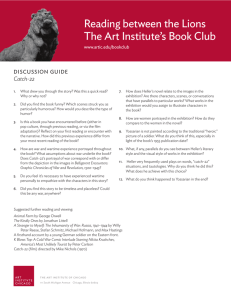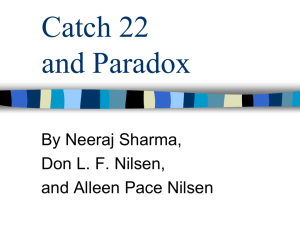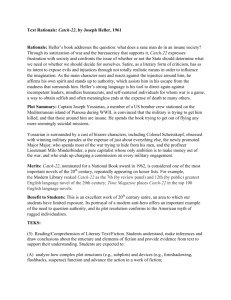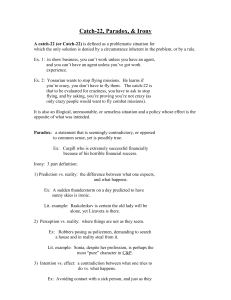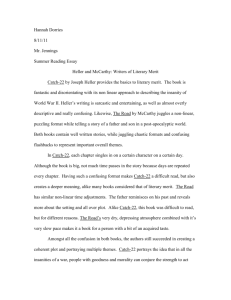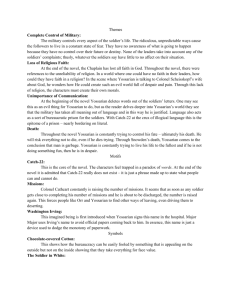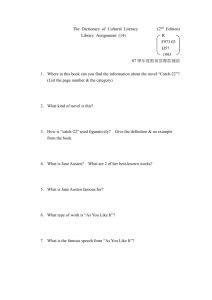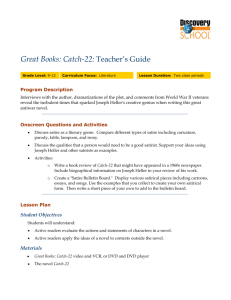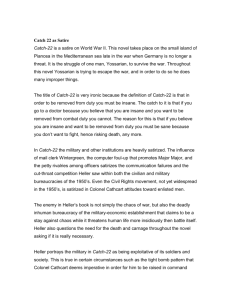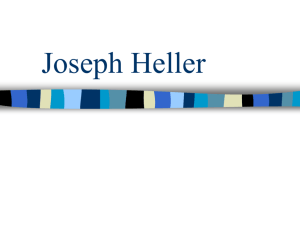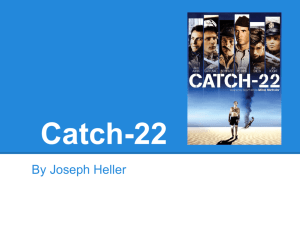Why Not Catch 21?: The Stories Behind the Titles Gary Dexter Catch
advertisement
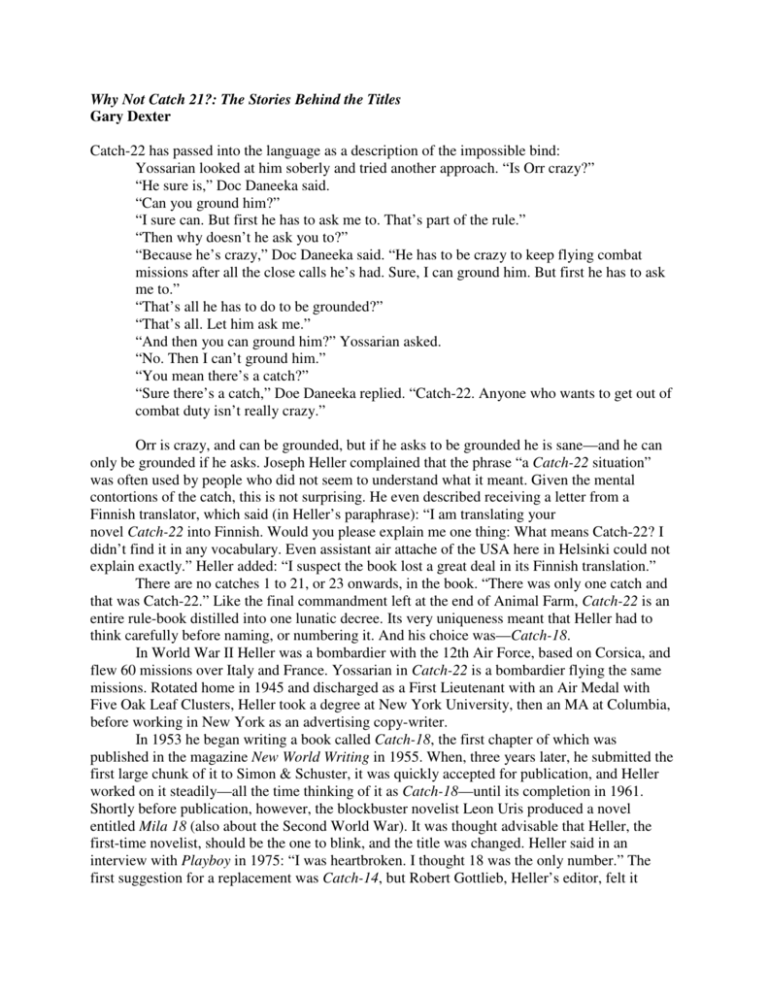
Why Not Catch 21?: The Stories Behind the Titles Gary Dexter Catch-22 has passed into the language as a description of the impossible bind: Yossarian looked at him soberly and tried another approach. “Is Orr crazy?” “He sure is,” Doc Daneeka said. “Can you ground him?” “I sure can. But first he has to ask me to. That’s part of the rule.” “Then why doesn’t he ask you to?” “Because he’s crazy,” Doc Daneeka said. “He has to be crazy to keep flying combat missions after all the close calls he’s had. Sure, I can ground him. But first he has to ask me to.” “That’s all he has to do to be grounded?” “That’s all. Let him ask me.” “And then you can ground him?” Yossarian asked. “No. Then I can’t ground him.” “You mean there’s a catch?” “Sure there’s a catch,” Doe Daneeka replied. “Catch-22. Anyone who wants to get out of combat duty isn’t really crazy.” Orr is crazy, and can be grounded, but if he asks to be grounded he is sane—and he can only be grounded if he asks. Joseph Heller complained that the phrase “a Catch-22 situation” was often used by people who did not seem to understand what it meant. Given the mental contortions of the catch, this is not surprising. He even described receiving a letter from a Finnish translator, which said (in Heller’s paraphrase): “I am translating your novel Catch-22 into Finnish. Would you please explain me one thing: What means Catch-22? I didn’t find it in any vocabulary. Even assistant air attache of the USA here in Helsinki could not explain exactly.” Heller added: “I suspect the book lost a great deal in its Finnish translation.” There are no catches 1 to 21, or 23 onwards, in the book. “There was only one catch and that was Catch-22.” Like the final commandment left at the end of Animal Farm, Catch-22 is an entire rule-book distilled into one lunatic decree. Its very uniqueness meant that Heller had to think carefully before naming, or numbering it. And his choice was—Catch-18. In World War II Heller was a bombardier with the 12th Air Force, based on Corsica, and flew 60 missions over Italy and France. Yossarian in Catch-22 is a bombardier flying the same missions. Rotated home in 1945 and discharged as a First Lieutenant with an Air Medal with Five Oak Leaf Clusters, Heller took a degree at New York University, then an MA at Columbia, before working in New York as an advertising copy-writer. In 1953 he began writing a book called Catch-18, the first chapter of which was published in the magazine New World Writing in 1955. When, three years later, he submitted the first large chunk of it to Simon & Schuster, it was quickly accepted for publication, and Heller worked on it steadily—all the time thinking of it as Catch-18—until its completion in 1961. Shortly before publication, however, the blockbuster novelist Leon Uris produced a novel entitled Mila 18 (also about the Second World War). It was thought advisable that Heller, the first-time novelist, should be the one to blink, and the title was changed. Heller said in an interview with Playboy in 1975: “I was heartbroken. I thought 18 was the only number.” The first suggestion for a replacement was Catch-14, but Robert Gottlieb, Heller’s editor, felt it didn’t have the right ring. “I thought 22 was a funnier number than 14”, Gottlieb told the New York Times Review of Books in 1967. Heller took two weeks to persuade. But the journey from 18 to 22, although tortuous, was worth making. The reason is this: 22 has a thematic significance that 18 or 14 do not. The doubling of the digits emphasizes a major theme of the book: duplication and reduplication. When the book was first published, critics objected to its monotony and repetition. “Heller’s talent is impressive,” said Time magazine, “but it is also undisciplined, sometimes luring him into bogs of boring repetition. Nearly every episode in Catch-22 is told and retold.” This is true. In Catch-22 everything is doubled. Yossarian flies over the bridge at Ferrara twice, his food is poisoned twice, there is a chapter devoted to “The Soldier Who Saw Everything Twice”, the chaplain has the sensation of having experienced everything twice, Yossarian can name two things to be miserable about for everyone to be thankful for, all Yossarian can say to the dying Snowden is “There, there”, all Snowden can say is “I’m cold, I’m cold”, Yossarian overhears a woman repeatedly begging “please don’t, please don’t”, and Major Major is actually Major Major Major Major. The critic JP Stern identified a pairing approach to the characters: Most figures in Catch-22 are arranged in pairs; e.g., the medical orderlies Gus and Wes; the HR clerk Wintergreen and the Chaplain’s orderly—both nasty characters; the two CID stooges; Major Major and Captain Flume—both persecuted; Generals Dreedle and Peckem—both harshly satirized; Snowden and Mudd—both dead; Piltchard and Wren— both enjoy combat missions; Aarfy and Black—men without feeling; Nately and Clevinger—upper-class college boys, both get killed; the nurses, Duckett and Kramer. The mad pairing reaches its apotheosis in the catch itself. As the novel says: “Yossarian saw it clearly in all its spinning reasonableness. There was an elliptical precision about its perfect pairs of parts that was graceful and shocking, like good modern art, and at times Yossarian wasn’t quite sure that he saw it at all, just the way he was never quite sure about good modern art...” Doubling is thus a stylistic device suggestive of the qualified nature of reality. Nothing is singular, unblurred or unambiguous. The title, with its doubled digits (2 representing duality, itself doubled to make 22) conveys this in a way that Catch-18 could not. It seems clear therefore that what happened when Simon & Schuster found out about Leon Uris’s book was a piece of great good luck.
